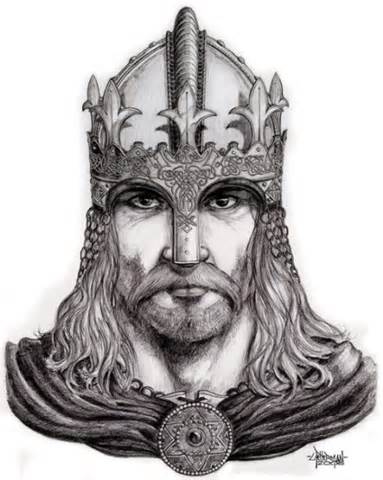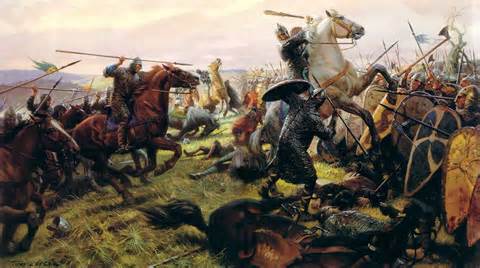The Battle of Hastings
The Battle of Hastings, which took place on October 14, 1066, was the last successful seaborne invasion of England. At the end of that day, Anglo-Saxon rule of England had ended and the Norman Conquest had begun. The battle was the last stage in a power struggle for the English throne that stretched back generations. When England's King Edward the Confessor died on January 5, 1066, the name of the man who would succeed him wasn't clear in everyone's minds. In fact, three powerful men thought they had a legitimate claim to the throne and decided to do something about it. These three men were Harald Hardrada, King of Norway; William, Duke of Normandy (in France); and Harold Godwinson, a Saxon who was Edward's trusted adviser.
William, Duke of Normandy, had been for a time the guardian of Edward the Confessor, when the latter was sent to Normandy to avoid Canute's Danish invasion. William paid Edward a state visit when the latter was king, and William later claimed that Edward made him a promise to name him the heir to the English throne. Further, William helped Harold Godwinson out of a jam and in return, William said, extracted a promise that Harold would support William's claim to the kingship when Edward died. William did have a blood connection: He was the nephew of Queen Emma.
Earl Godwin had another son, Tostig, who was not initially distressed to see his brother on the throne, especially because Tostig got the plum appointment of Earl of Northumbria. But Tostig grew restless and stirred up too much of the countryside, forcing Harold to act in the country's best interest and banish Tostig from England's shores. Trouble was, Tostig found a willing ally in Norway in the form of Harald Hardrada, who wanted a piece of England (actually the throne) for himself. Tostig and Harald conspired, and the result was an initial harrying expedition by Tostig and his forces and then a main invasion by Harald and his forces, both of which convinced King Harold to force march with a few thousand troops to do some harrying of his own. The result was resounding victory at the Battle of Stamford Bridge, on September 25. William, meanwhile, had been building up his invasion force and looking for an opportunity to strike. He took his time, securing a larger fighting force through the promise of lands and titles. He even gained the support of the Pope for his claim to the throne. William didn't like the weather or the omens all that much throughout the summer but finally agreed to set sail on September 12. The crossing wasn't as straightforward as it might seem from looking at a map; and by the time William and all of his ships and men arrived on the southeastern coast of England, it was September 28. (They had been delayed a bit by a storm in the English Channel.) Harold's victory celebrations at Stamford Bridge were short-lived, first because he and his troops had to do a bit of extra work to pacify the countryside, which his brother Tostig had sufficiently stirred up, and second because the news of William's invasion reached Harold's ears and eyes not long after William reached England. William, meanwhile, set about harrying the southern countryside, trying to stir up support for his claim to the throne, based on the people's familiarity with Norman customs dating back to Queen Emma and on some nobles' dissatisfaction with Harold's rule. William ensconced himself near the town of Hastings. Harold and his forces marched 260 miles southward, reaching the area on October 13. Seeking battle, Harold set about ensconcing himself and his forces on the high ground, in this case Senlac Ridge, on Caldbec Hill, six miles north of Hastings. The Saxons made quick work of setting up a defensive perimeter, including a fence of sharpened stakes behind which the defenders would stand. Certain that the fighting would start the next day, Harold issued orders that his troop should stand their ground no matter what happened, since their position atop a hill behind a ditch and a line of sharp stakes offered them better cover than did the open ground down the hill and out into the plains on which William's army, having marched a few miles from the Hastings area, was gathered. The Saxon army consisted of a large number of well-trained housecarls, the king's personal bodyguards; a large number of the Fyrd, the local leaders of each shire; and other troops as needed. Sources differ on how many men formed the Saxon side on that fateful day. Several sources agree that the number was between 5,000 and 7,000. The preferred weapon, of those who could afford one, was the giant Danish axe, which could be swung in a wide arc and carried enough power and devastation to cut down both horse and rider. The Saxons were also well defended with large wooden shields, which they were practiced at interlocking and using to good effect in turning back enemy charges.
William opened the battle by commanding a wide spread of arrow fire. Once the Norman arrow supply was exhausted, with little apparent effect on the Saxon defenders atop the hill, William ordered a cavalry charge. The combination of the heavy horse carrying armored knights and a sharp gallop uphill meant that the Saxon defenders, stationary though they were, could negate the normal advantage of charging cavalry. The Saxon Wall held again, not the least because the defenders were wielding heavy axes that could cut down both horse and rider. William reappeared, removed his helmet so his troops could see that he was indeed alive, and the result was a renewed attack. Caught rushing downhill or, in some cases, on the flat, the less mobile Saxons found themselves outnumbered and outflanked and, then, cut to pieces. Harold urged his troops to hold their lines, but a few more Norman "attack-retreat-attack" iterations resulted in many more Saxon deaths. The Normans, mindful of the Saxon Wall and the heavy axes, were cautious in a renewed attack. But another attack came, and another one followed that. Eventually, the Norman charge succeeded, overwhelming the Saxon defenses and resulting in the death of Harold himself, who some sources say was gravely wounded by an arrow to the eye and then the victim of a fierce Norman charge toward the end of the day. Their leader gone, the Saxon force dissolved into full-blown retreat, and the result was the Normans' claiming the hill and victory.
|
|
Social Studies for Kids
copyright 2002–2025
David White



 Harald Hardrada was a distant relative of
Harald Hardrada was a distant relative of  Harold was the son of Earl Godwin and the brother-in-law of King Edward. Earl Godwin and Edward had their differences, but Godwin proved too powerful to ignore and his son Harold carried on the family name and way, such that Harold was with the king when he died. Harold claimed that Edward agreed on his deathbed to give England over to Harold's "protection." Harold had the support as well of the Witangamot, the powerful nobles who had made a habit of offering the kingship to the "chosen" ones. Harold, indeed, who was crowned King of England on January 6, the day after Edward the Confessor died.
Harold was the son of Earl Godwin and the brother-in-law of King Edward. Earl Godwin and Edward had their differences, but Godwin proved too powerful to ignore and his son Harold carried on the family name and way, such that Harold was with the king when he died. Harold claimed that Edward agreed on his deathbed to give England over to Harold's "protection." Harold had the support as well of the Witangamot, the powerful nobles who had made a habit of offering the kingship to the "chosen" ones. Harold, indeed, who was crowned King of England on January 6, the day after Edward the Confessor died.  William's army was made up of Bretons, Burgundians, Flemish, French, and Normans, sporting cavalry and archers in addition to infantry. Archers had short bows, mounted knights had swords and spears, and infantry had a mix of handheld weapons.
William's army was made up of Bretons, Burgundians, Flemish, French, and Normans, sporting cavalry and archers in addition to infantry. Archers had short bows, mounted knights had swords and spears, and infantry had a mix of handheld weapons. 
